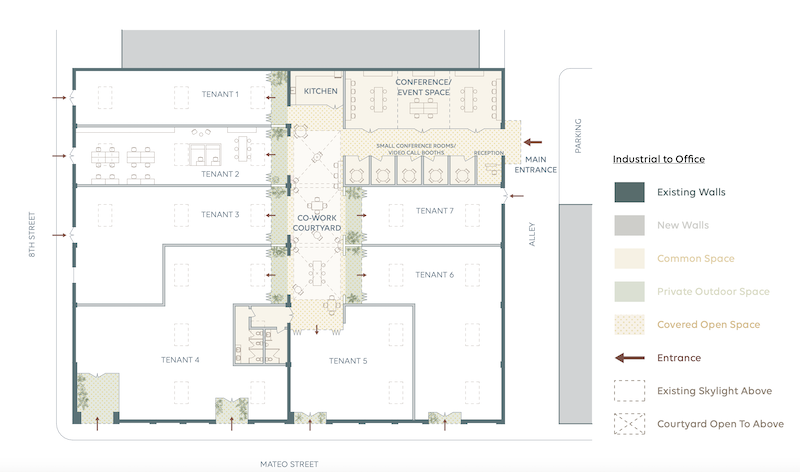The Los Angeles-based design firm Omgivning has released three white papers that propose new ways, post-COVID 19 pandemic, of looking at workplaces, multifamily, and urban reprogramming.
The firm’s ideas revolve around four unifying themes:
• Human-centric design
• Flexibility and adaptability
• Blended uses
• The relationship of space and economic context
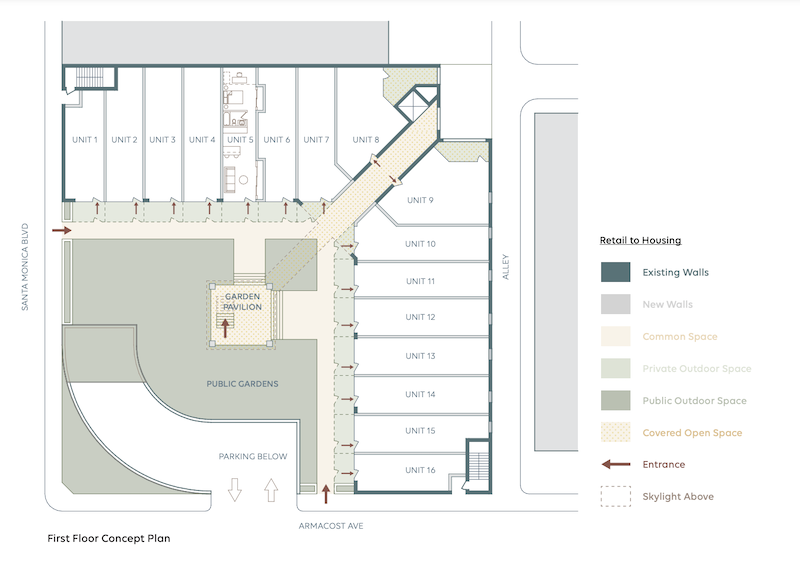
Big-box retail, which is under stress from online shopping, could be rethought for residential conversion with lots of open public areas.
Karin Liljegren, FAIA, IIDA, Omgivning’s founder and Principal, in 1999 worked on the very first projects under Los Angeles’ Adaptive Reuse Ordinance. Her firm’s recent white papers assume that changing social norms have created excess and unused capacity in the built environment. Those assumptions drive the various alternative concepts that Omgivning has devised, with an eye always toward reusing, as opposed to tearing down, existing buildings.
For example, Omgivning’s multifamily paper cites Preservation Positive, a report released by the LA Conservancy in 2020, that approximately three-fifths of Angelenos rent while the city remains in the middle of an ongoing housing crisis. “Rather than build itself out of this crisis, where the average cost to produce one new unit of subsidized affordable housing is at least $400,000, we should seek to find a more cost-effective, creative, and sustainable approach. Through enhancing the city's residential stock in existing buildings, we can help fill the gap toward achieving the City's housing goals.”
BREAKING DOWN THE MULTIFAMILY FORM
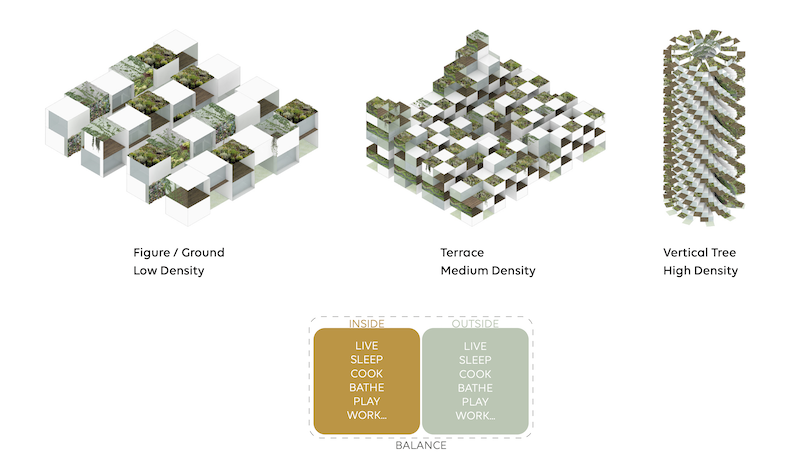
Multifamily buildings can achieve different density levels, depending on the amenities and biophilia included.
The multifamily paper offers four concepts:
• Humanizing the urban experience by providing features for existing urban apartment buildings that contribute to a greener, more porous city;
• Expanding unit types through designs that integrate diversity and flexibility into spaces for the inhabitants' various needs;
• Common spaces that emphasize a connection to nature, expand private work options in communal environments, and introduce on-site commerce; and
• Transforming interiors whose components are designed to be "both/and" solutions to meet multiple needs, as opposed to "either/or" that only allow for a single use.
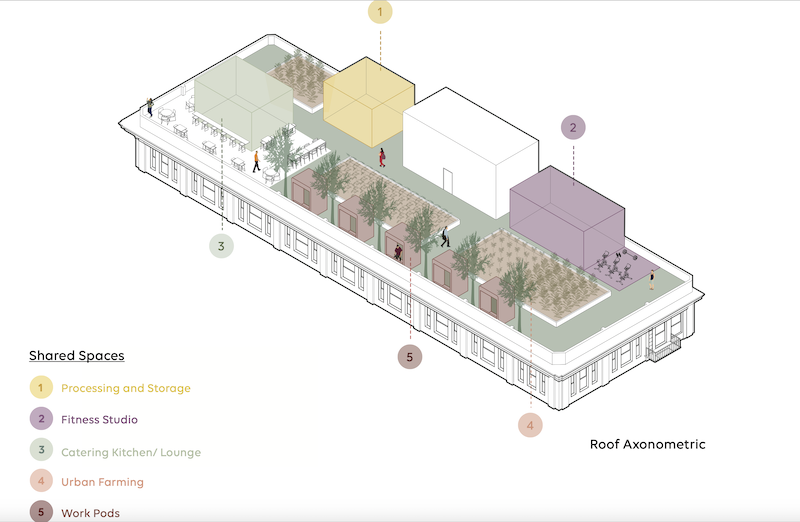
Shared and common spaces that could include roofdeck “work pods” are central to Omgivning's multifamily concepts.
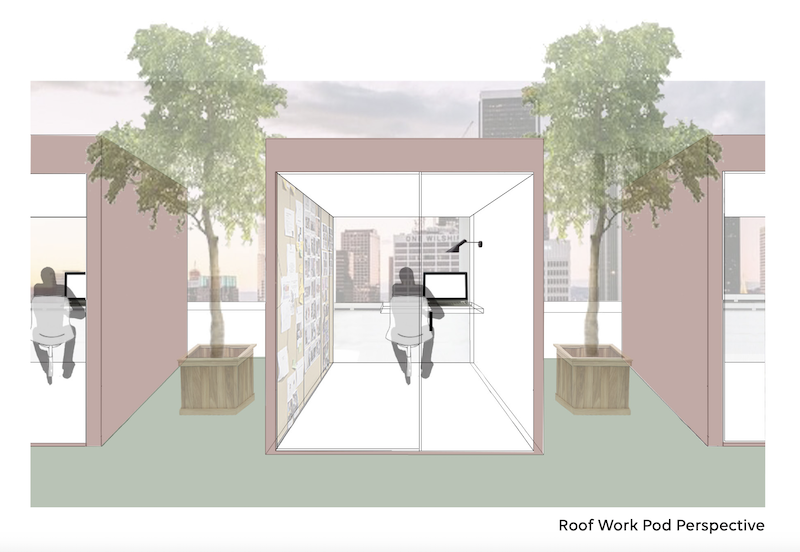
The paper deconstructs the multifamily form to incorporate open-ended light courts that allow natural light and ventilation to flow throughout. Its concepts expand the unit types within buildings to include two-story two-family, as well as private and “gather” zones.
“Opportunities also exist to create new experiences and interactions in areas once relegated to back of house,” the paper states, “or typically common to the street and sidewalk.” That might include relocating the mailroom to the front of the building and adding refrigerated boxes and larger parcel rooms. “Even the simple act of picking up mail presents a greater chance of engaging with neighbors.”
PODS FOR DIFFERENT USES
Omgivining is a big advocate for incorporating “pods” into its reimagining of buildings for privacy and utility. Pods are part of one of the firm’s alternate multifamily unit types. And Omgivning’s workplace paper presents three pod types that accommodate a broad range of needs:
The View Pod, designed for maximum resilience that supports unexpected shelter-in-place requirements. Enclosed on all sides with one main opening directed towards a chosen view, these pods could face exterior windows or a common open space within the office. In its workspace scenario, The View ensures privacy and sound isolation, while remaining visually connected to elements beyond. The sleep scenario can host a mattress for an overnight stay.
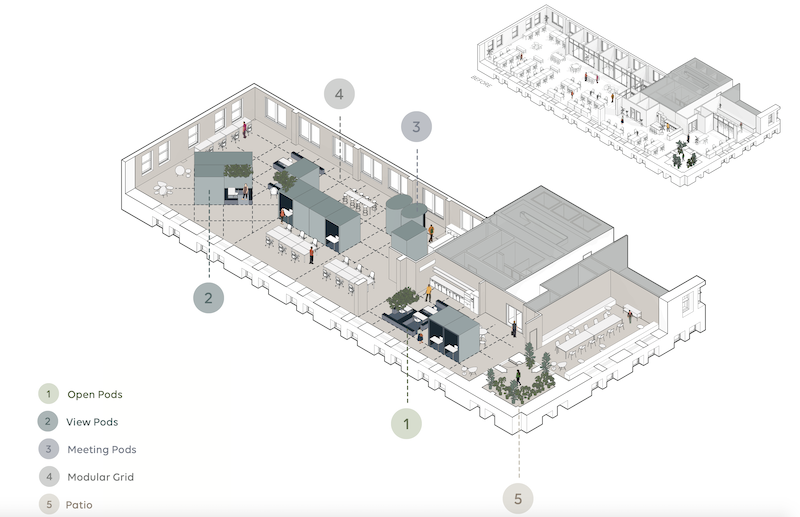
Omgivning reimagines the workplace with different kinds of intimate spaces, such as its “work-meet” pod that allows for privacy and collaboration.
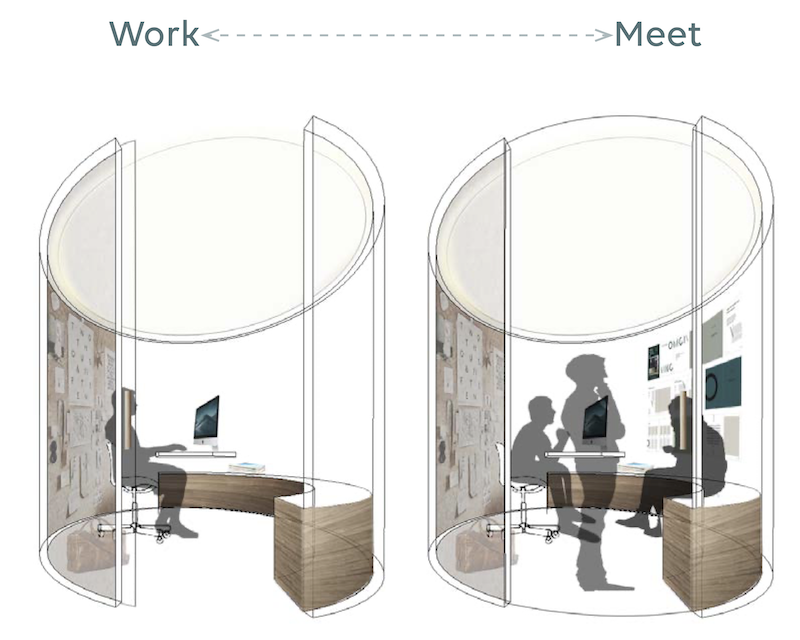
The Meeting Pod, which provides flexibility for open or enclosed meetings. Its circular footprint provides acoustic privacy for video calls and to aid in focus. Built-in millwork offers dual functions for seating and storage. Integrated lighting and tackable surfaces present a clean background for personalization and work-based pin-ups.
The Open Pod, which provides a modular footprint with varying barrier preferences. It defines an individual space while staying visually connected to the communal space. The barrier preferences are adjustable to an open or enclosed layout, based on the occupant's needs. Greenery, suspended from above or in planters, can be used to define zones and remind inhabitants to prioritize wellbeing. The Open Pod provides built-in lockers, open shelving and the option for a height-adjustable desk.
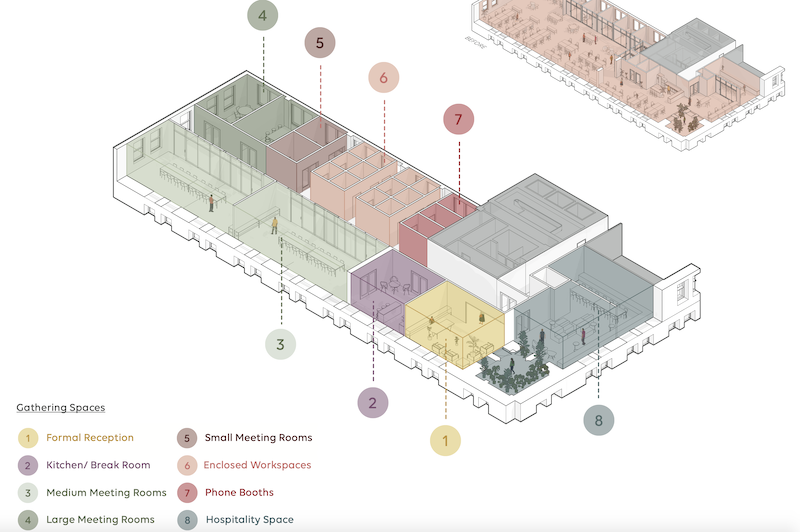
The workplace needs places where employees can still congregate safely.
The workplace paper also offers reuse concepts for gathering spaces and for better infection control, the latter of which helps employers assess workers’ needs by developing targeted protocols that focus on human impacts.
REVIVING TIRED RETAIL AND WAREHOUSE SPACE
In its paper on reimagining urban reprogramming, Omgivning cites experts who anticipate that 90% of real estate development over the next decade will focus on renovation and resuse, rather than new construction.
To that end, this paper proposes ways to transform struggling strip malls (there are 675 malls in Los Angeles alone), big-box retail (using an existing vacant 150,000-sf Costco in L.A. as its starting point), light-industrial warehouses, and urban ground-floor commercial space.
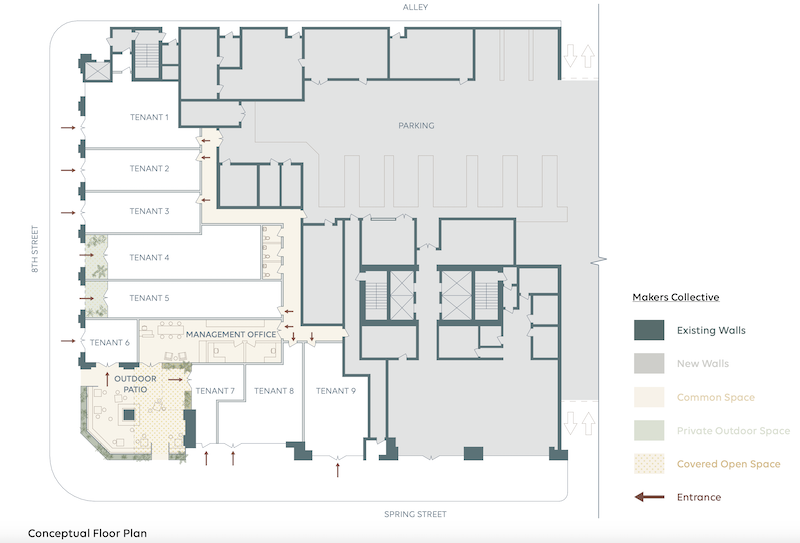
Light industrial space could be converted to leasable maker spaces.
Its vision for converting retail space to housing includes one configuration showing a mini-mall with the capacity to hold 30 600-sf affordable residential units, each outfitted with work-from-home capabilities, and an outdoor patio or courtyard.
Omgivning’s reuse of light industrial space includes an office concept that’s organized around a centrally located courtyard that provides users with cross ventilation, natural light, and connection to green outdoor space. It also conceived a live-work concept that carves up the building into smaller, more affordable lofts that are linked through outdoor courtyards, and are circulation-rich with greenery.

Restaurants and offices share some common traits that could be combined for converting ground-floor retail.
Transforming ground-floor retail could encompass what Omgivning calls a Makers Collective concept, where a master tenant, or even an existing building management company, can lease a large space and subdivide it into smaller units for individuals or small startups. The program consists of shared space to house equipment needed by the tenants, and a shared space for events and periodic showcases of the community’s products. An outdoor lounge and garden provide a communal gathering space.
Omgivning even goes so far as to suggest a restaurant/office hybrid concept that reduces each footprint by sharing the varied seating arrangements within a restaurant to accommodate individual and collaborative work.
Related Stories
Adaptive Reuse | Jul 27, 2023
Number of U.S. adaptive reuse projects jumps to 122,000 from 77,000
The number of adaptive reuse projects in the pipeline grew to a record 122,000 in 2023 from 77,000 registered last year, according to RentCafe’s annual Adaptive Reuse Report. Of the 122,000 apartments currently undergoing conversion, 45,000 are the result of office repurposing, representing 37% of the total, followed by hotels (23% of future projects).
Urban Planning | Jul 26, 2023
America’s first 100% electric city shows the potential of government-industry alignment
Ithaca has turned heads with the start of its latest venture: Fully decarbonize and electrify the city by 2030.
Multifamily Housing | Jul 25, 2023
San Francisco seeks proposals for adaptive reuse of underutilized downtown office buildings
The City of San Francisco released a Request For Interest to identify office building conversions that city officials could help expedite with zoning changes, regulatory measures, and financial incentives.
Sustainability | Jul 13, 2023
Deep green retrofits: Updating old buildings to new sustainability standards
HOK’s David Weatherhead and Atenor’s Eoin Conroy discuss the challenges and opportunities of refurbishing old buildings to meet modern-day sustainability standards.
Multifamily Housing | Jul 11, 2023
Converting downtown office into multifamily residential: Let’s stop and think about this
Is the office-to-residential conversion really what’s best for our downtowns from a cultural, urban, economic perspective? Or is this silver bullet really a poison pill?
Adaptive Reuse | Jul 10, 2023
California updates building code for adaptive reuse of office, retail structures for housing
The California Building Standards Commission recently voted to make it easier to convert commercial properties to residential use. The commission adopted provisions of the International Existing Building Code (IEBC) that allow developers more flexibility for adaptive reuse of retail and office structures.
Adaptive Reuse | Jul 6, 2023
The responsibility of adapting historic university buildings
Shepley Bulfinch's David Whitehill, AIA, believes the adaptive reuse of historic university buildings is not a matter of sentimentality but of practicality, progress, and preservation.
Multifamily Housing | Jun 19, 2023
Adaptive reuse: 5 benefits of office-to-residential conversions
FitzGerald completed renovations on Millennium on LaSalle, a 14-story building in the heart of Chicago’s Loop. Originally built in 1902, the former office building now comprises 211 apartment units and marks LaSalle Street’s first complete office-to-residential conversion.
Multifamily Housing | May 23, 2023
One out of three office buildings in largest U.S. cities are suitable for residential conversion
Roughly one in three office buildings in the largest U.S. cities are well suited to be converted to multifamily residential properties, according to a study by global real estate firm Avison Young. Some 6,206 buildings across 10 U.S. cities present viable opportunities for conversion to residential use.
Multifamily Housing | May 16, 2023
Legislators aim to make office-to-housing conversions easier
Lawmakers around the country are looking for ways to spur conversions of office space to residential use.cSuch projects come with challenges such as inadequate plumbing, not enough exterior-facing windows, and footprints that don’t easily lend themselves to residential use. These conditions raise the cost for developers.


